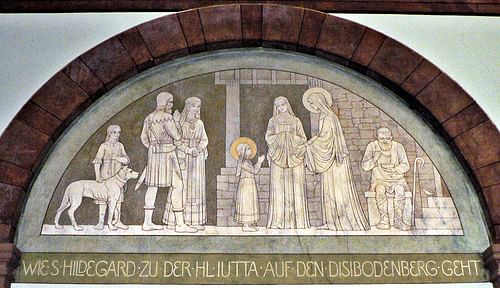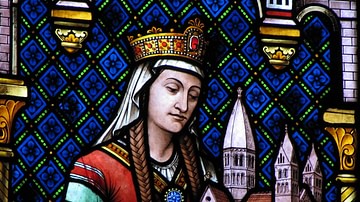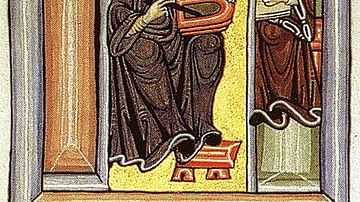
Hildegard of Bingen (also known as Hildegarde von Bingen, l. 1098-1179) was a Christian mystic, Benedictine abbess, and polymath proficient in philosophy, musical composition, herbology, medieval literature, cosmology, medicine, biology, theology, and natural history. She refused to be defined by the patriarchal hierarchy of the Church and, although she abided by its strictures, pushed the established boundaries for women.
Along with her impressive body of work and ethereal musical compositions, Hildegard is best known for her spiritual concept of Viriditas – “greenness” - the cosmic life force infusing the natural world. For Hildegard, the Divine manifested itself and was apparent in nature. Nature itself was not the Divine but the natural world gave proof of, existed because of, and glorified God. She is also known for her writings on the concept of Sapientia – Divine Wisdom – specifically immanent Feminine Divine Wisdom which draws close to and nurtures the human soul.
From a young age, she experienced ecstatic visions of light and sound, which she interpreted as messages from God. These visions were authenticated by ecclesiastical authorities, who encouraged her to write her experiences down. She would become famous in her own lifetime for her visions, wisdom, writings, and musical compositions, and her counsel was sought by nobility throughout Europe.
Early Life & Education
Hildegard came from an upper-class German family, the youngest of ten children. She was often ill as a child, afflicted with headaches which accompanied her visions, from around the age of three. Whether her parents consulted physicians about her health issues is unknown, but at the age of seven, they sent her to be enrolled as a novice in the convent of Disibodenberg.
Hildegard was placed under the care of Abbess Jutta von Sponheim (l. 1091-1136), head of the order, an aristocrat and daughter of a count who had chosen the monastic life for herself. Jutta was only six years older than Hildegard in 1105 when the latter entered the convent and the two would become close friends. Jutta taught Hildegard to read and write, how to recite the prayers, and introduced her to music by teaching her to play the psaltery (a stringed instrument like a zither). Jutta may also have instructed the younger girl in Latin (though this claim has been challenged) and encouraged her to read widely.
During this time, she was also instructed by a monk named Volmar (d. 1173) who served as prior to the convent and the nuns' confessor (since women were not allowed to hear confession, celebrate Mass, or preside over any official assembly other than meetings of other women regarding the day-to-day upkeep of their community). Hildegard had told Jutta about her visions, and Jutta felt it her duty to inform Volmar. Volmar encouraged Hildegard to believe in the authenticity of the visions and to write about them. He may have also been the one to teach her Latin and introduce her to various forms of literature. After seven years of tutelage and service, at the age of fourteen, Hildegard made her profession of faith and was accepted into the order.

Hildegard and Jutta were typical of the nuns at this time in that they came from upper-class, aristocratic families who could afford to pay the Church to take their daughters. Although it was officially forbidden to accept money from parents, nunneries required a substantial 'dowry' for a girl to be accepted, claiming it would go to her upkeep. These dowries took the form of deeds to lands, cash, expensive clothing, and similar valuables. Daughters of poor families could not afford the dowry and, if they wanted to participate in convent life, it was as maids or cooks. Scholars Frances and Joseph Gies comment on the attraction of the convent for young women in the Middle Ages:
For upper-class women, the convent filled several basic needs. It provided an alternative to marriage by receiving girls whose families were unable to find them husbands. It provided an outlet for nonconformists, women who did not wish to marry because they felt a religious vocation, because marriage was repugnant, or because they saw in the convent a mode of life in which they could perform and perhaps distinguish themselves. The nunnery was a refuge of female intellectuals. (64)
Hildegard certainly fit this paradigm of the female intellectual, distinguishing herself by her vast learning, devotion to God, and service to others. When Jutta died in 1136, Hildegard, then 38 years old, was unanimously chosen to succeed her.
Visions & Move to Rupertsberg
From the time she was young, Hildegard had feared and resisted her visions but was supported and encouraged to accept them by Volmar. A few years after becoming abbess, she began receiving the visions more vividly than before and with such frequency that she became bed-ridden. She had confessed her visions to the Abbot Kuno, who presided over her order, and he encouraged her to write about them, but she refused.
The visions themselves then became insistent that she write them down and interpret them for an audience. Hildegard resisted until she fell into delirium in which the visions, constantly recurring, demanded she express them in writing. She relates:
In this affliction I lay thirty days while my body burned as with fever…And throughout those days I watched a procession of angels innumerable who fought alongside Michael against the dragon and won the victory. And one of them called out to me, 'Eagle! Eagle! Why Sleepest thou? Arise! For it is dawn – and eat and drink!' Instantly my body and my senses came back into the world and, seeing this, my daughters [fellow nuns] who were weeping around me lifted me from the ground and placed me on my bed and thus I began to get my strength back. (Gies, 78)
Encouraged by Volmar and Abbot Kuno and inspired by the visions themselves, Hildegard began to write her best-known work, the Scivias (shortened form of the Latin Scito vias Domini – “Know the Way of the Lord”– , composed c. 1142-1151) which, in accordance with her visions' instructions, related what she saw and what she felt they meant. By this time, she was a well-established visionary, renowned for her wisdom, and much sought after for counsel. Pope Eugenius (served 1145-1153) read parts of the Scivias, approved the visions as authentic revelations, and encouraged Hildegard to continue the work. People would visit Disibodenberg to seek her out and, afterwards, would have been gently reminded by Abbot Kuno to leave a donation before they departed.

In 1147, Hildegard requested leave to found her own convent in Rupertsberg, 65 miles (105 km) to the south-east. Her request sparked a dispute with Abbot Kuno who denied her permission and suggested she accept the position of Prioress at Disibodenberg and place herself under his authority. His reasons for refusal are never recorded but most likely he was reluctant to lose so great an asset as Hildegard who not only brought in significant revenue but managed to keep the convent running efficiently and conduct correspondence with important figures who might be inclined to donate further.
Hildegard refused to accept Kuno's decision, repeated her request, and when Kuno denied her a second time, she took the matter to the Archbishop of Mainz who approved it. Kuno still would not release her or the nuns until Hildegard, bed-ridden (possibly due to her visions), informed him that God himself was punishing her for not following His will in moving the nuns to Rupertsberg. Hildegard was stricken with a paralysis so severe that no one could move her arms or legs and, after witnessing this, Kuno relented and allowed the nuns to leave. Hildegard established the convent at Rupertsberg c. 1150 with 18 nuns and her friend the monk Volmar as their confessor.
Works & Beliefs
Hildegard's vision is all-encompassing in scope, far transcending the common vision of the medieval Church while still remaining within the bounds of orthodoxy. She claimed the Divine was as female in spirit as male and that both these elements were essential for wholeness. Her concept of Viriditas elevated the natural world from the Church's view of a fallen realm of Satan to an expression and extension of the Divine. God was revealed in nature, and the grass, flowers, trees, and animals bore witness to the Divine simply by their existence.
Her first major work, the Scivias, relates 26 of her visions in three sections – six visions in the first, seven in the second, thirteen in the third – along with her interpretation and commentary on the nature of the Divine and the role of the Church as an intermediary between God and humanity. She depicts God as a cosmic egg, both male and female, pulsing with love; the male aspect of the Divine is transcendent while the female is immanent. It is this immanence which invites rapport with the Divine.
Hildegard believed that, prior to the Fall of Man, God was worshipped by celestial song which, after the Fall, was approximated by music as humans now heard and understood it. Music, then, was the best expression of one's love for, devotion to, and worship of God. In keeping with this belief, she ends the Scivias with the text of her morality play Ordo Virtutum and her Symphony of Heaven, one of her earliest musical compositions.
Throughout her time at Disibodenberg, Hildegard routinely practiced what is known today as “holistic healing” using resonant spiritual energies and natural remedies to maintain health and cure illness and injury. Between 1150-1158 she composed her Liber Subtilatum (“Book of Subtleties of the Diverse Qualities of Created Things”) comprised of two sections, her Physica (“Medicine”) and Causae et Curae (“Causes and Cures of Disease”). She argues that human beings are the pinnacle of God's creation and the natural world exists in harmony with humanity; humans should care for nature and nature will do the same.
Her concept of health was based on the prevailing understanding, derived from ancient Greek medicine, of a human body's health depending on the balance of four humors of the body: sanguine/peaceful/dry (blood), choleric/angry/hot (yellow bile), phlegmatic/apathetic/moist (phlegm), melancholy/depressed/cold (black bile). Hildegard's conception of the humors differed slightly but still conformed to the traditional understanding. When these humors were in balance, the body was in optimum health; sickness indicated imbalance. Hildegard recommended herbal remedies, hot baths, proper sleep patterns, a healthy diet, and a positive attitude to keep one in balance or bring a sick person back to a balanced, healthy state.
An essential aspect of health was virtuous conduct and Hildegard addressed this in her morality play Ordo Virtutum (“Order of the Virtues”), completed in 1151. The play depicts the struggle of the soul, trapped in the flesh, between the call of the virtues and the temptations of the devil. This work was performed by Hildegard and her nuns as the chorus of virtues and the soul (a female voice), male clergy singing the roles of the patriarchs and prophets, and most likely Volmar in the role of Satan – the only character in the play who does not sing since Satan is incapable of producing music, the true praise of God. Ordo Virtutum is the oldest medieval morality play and the only medieval musical extant.

Hildegard was especially proficient at Rupertsberg and next produced her Liber Vitae Meritorum (“Book of Life's Merits”) between 1158-1163. This work expands and develops the theme of her earlier play as it discusses the struggle of the soul between virtue and vice, the true nature and final rewards of both, the reason for the soul's struggle, and the immanence of God's presence and redeeming love. In this work she also wrote on human sexuality, specifically female sexuality, describing a woman's orgasm as the spiritual force which enfolds the man's seed in the womb and holds it there. The depth of the passion the parents felt for each other during sex would determine the child's character; if they were in love, then the orgasm of both would be strong and the child would be healthy and happy; if they were not, then the child would be bitter and imbalanced.
She then wrote her grand theological opus, Liber Divinorum Operum (“Book of Divine Works”) between 1164-1174, which drew together the themes of her previous works but elevated all through the grand scale of her further visions and explication of the nature of the Divine Love (Caritas) and Divine Wisdom (Sapientia) represented as feminine energies radiating light.
Her concept of Viriditas is also explored more fully in this work. The 'greenness' of the natural world is reflected in the 'greenness' of the human soul receptive to the Divine, which blooms to life once connected to the cosmic life force. Cut off from Divine Love, the soul is at the mercy of vice which leads only to misery and death. The natural and life-affirming choice is to embrace the Divine as the essential and enduring energy of existence, recognizing that the virtues call one toward an elevated, transcendent reality. Music, of course, is intertwined with this concept of 'greenness' as it elevates the soul in praising the source of all life.
Correspondences & Controversies
While composing her written works and musical scores (still popular and performed in the present day), Hildegard also kept up a correspondence with kings, queens, ecclesiastical authorities, and many others. She exchanged letters, still extant, with such medieval luminaries as Bernard of Clairvaux (l. 1090-1153), Thomas Becket (l. 1118-1170), Henry II (l. 1133-1189), Eleanor of Aquitaine (l. c. 1122-1204), Holy Roman Emperor and King of Germany Frederick Barbarossa (l. 1122-1190), and many others. She was never afraid of controversy or criticism and never failed to stand up to patriarchal ecclesiastical or secular authority for what she believed was right.
She went on four speaking tours which included stops in Cologne, Trier, Wurzburg, Frankfurt, and Rothenburg as well as trips into Flanders. These tours were expressly to deliver sermons to predominantly male audiences in spite of St. Paul's injunction against women speaking in the presence of men, having authority over men, or teaching men (I Timothy 2:12-14, I Corinthians 11:3, I Corinthians 14:34) and a central focus of her sermons was the corruption of the church and the need for immediate and drastic reform.
Even in her early eighties, Hildegard refused to be bullied or cowed by male authority figures. The Archbishop of Mainz ordered her to exhume the body of a young man, buried in holy ground at Rupertsberg, who had died excommunicated. Hildegard refused, claiming that the man had sought absolution and received grace and it was only the Archbishop's personal stubbornness and pride which prevented him from recognizing this. She traveled twice to Mainz to plead her case but was denied, and her convent was placed under interdict. Only when the Archbishop died was the interdict lifted and Hildegard and her nuns regarded as having been returned to a state of grace in the Church.
Conclusion
Aside from her contributions to theology, philosophy, music, medicine, and the rest, Hildegard invented the constructed script of the Litterae ignotae (alternate alphabet), which she used in her hymns for concise rhyming and, possibly, to lend to her text a sense of another dimension and higher plane. She also invented the Lingua ignota (unknown language), her own philological construct of 23 letters which served to separate and elevate her order from the mundane world.
In spite of her accomplishments and fame, the Church continued to regard women not only as second-class citizens but dangerous temptations and obstacles to virtue. The highly influential Bernard of Clairvaux claimed that a man could not associate with a woman without desiring sex with her and the canonical order of the Premonstratensians banned women from their order claiming to have recognized "that the wickedness of women is greater than all the other wickedness in the world" (Gies, 87). It was precisely this kind of misogynistic mindset that Hildegard struggled against not only within the Church but in medieval society at large.
Even so, the significance of her work was recognized by the Church and she was singled out as a woman of note. Her cause of death is unknown but she died, most likely of natural causes, in 1179. Attempts to canonize her stalled until 2012 when she was recognized as a saint through the process of Equivalent Canonization and was proclaimed a Doctor of the Church by Pope Benedict XVI. Her famous visions are today interpreted as symptoms of a migraine sufferer but this has in no way detracted from her reputation.
In 1979, the artist Judy Chicago included Hildegard of Bingen in her installation artwork The Dinner Party (currently on display at the Brooklyn Museum, New York, USA), an ornate triangular table with settings for 39 women from history and literature celebrating their contributions to world culture and knowledge. The names of another 999 women are engraved on the floor the table rests on. Hildegard would no doubt enjoy her place at the table between Eleanor of Aquitaine and accused-witch Petronilla de Meath (1300-1324), executed for heresy; two of the many women celebrated in the work for who they were and the message they continue to offer the world.





